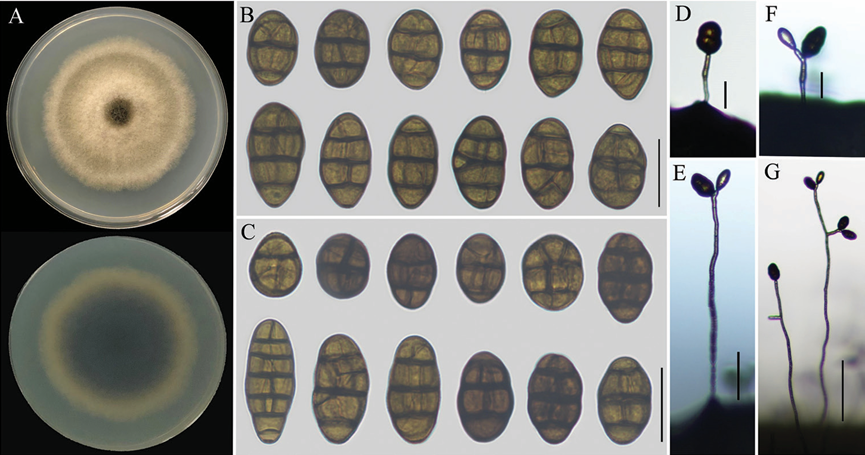 108
108
Alternaria divaricatae L. He & J.X. Deng, sp. nov.2021
MycoBank No: 838893
Holotype: China, Sichuan Province, Chengdu City, Wenjiang District, Herb Garden of Cheng du University of Traditional Chinese Medicine, from leaf spot of Saposhnikovia divaricata. 17 June, 2015, J.X Deng, (YZU-H-0029, holotype), ex-type culture YZU 151055.
Morphological description
Sexual morph: Colonies on PDA (Fig. 2A) vinaceous buff, hazel in the center, vel vety, cottony, dark mouse grey to pale mouse grey in reverse, 56‒64 mm in diam.; On PCA, conidiophores arising directly from lateral or apical of aerial hyphae or medium, lightly flexuous, sometimes geniculate at apex, smooth-walled, 9–36 × 3.5–6 μm, 1–3 transverse septa, the aerial hyphae sometimes up to 82–400 × 4–6 μm; conidia solitary from apex or geniculate loci, short-ovoid, subglobose, ellipsoid, 21–38 × 12–26 μm, with 1–4 transverse septa and 1‒4 longitudinal septa (Fig. 2B, D, E); On V8A, conidi ophores 10–26 (–53) × 3–4 μm, 1‒7 transverse septa, conidia 22–39 × 13–24 μm, 1‒4 transverse septa, 1‒3 longitudinal or oblique between septa (Fig. 2C, F, G). There was no secondary conidium production observed on PCA and V8A medium.
Asexual morph: Undetermined
Culture characteristics:
Habitat:
Distribution: China
GenBank Accession: ITS MW541932; GAPDH -; TEF1 MW579314; RPB2 MW579316
ITS MW541933; GAPDH -; TEF1 MW579315; RPB2 MW579317
Notes: Phylogenetically, Alternaria divaricatae forms a distinct clade in section Radicina, which appears to be sister to a clade including A. petroselini, A. selini and A. vulgarae (Fig. 1). Morphologically, A. divaricatae was different from A. petroselini, A. selini and A. vulgarae by producing smaller conidia (Table 2) and special sporulation from apex or geniculate loci of lateral or apical of aerial hyphae. Moreover, A. chla mydosporifera, A. glehniae and A. smyrnii grouped together and clustered as a sister clade with A. divaricatae, A. petroselini, A. selini and A. vulgarae (Fig. 1). Obviously, the conidia of A. divaricatae was smaller than A. smyrnii (Table 2) and A. divaricatae could be also easily differentiated from A. chlamydosporifera by the lack of chlamydospores in culture (Marin-Felix et al. 2019). Meanwhile, A. glehniae was distinguished from A. divaricatae by its single conidium on apex of conidiophore (there was no geniculate sporulation loci) and production of secondary conidium (Tao et al. 2019). In addition, A. radicina and A. carotiincultae were distinguished from present species by distant phylogenetic relationship in section Radicina.
Reference: [1] He, L. , Cheng, H. , Zhao, L. , Htun, A. A. , & Li, Q. L. . (2021). Morphological and molecular identification of two new alternaria species (ascomycota, pleosporaceae) in section radicina from china. MycoKeys, 78, 187-198.
Morphological characteristics of Alternaria divaricatae (strain: YZU 151055). Colony on PDA for 7 days at 25 °C (A); Conidia on PCA and V8A (B, C); Sporulation patterns from PCA and V8A (D–G: D, E from PCA F, G from V8A); Scale bars: 25 μm (B, C); 2 μm (D, F); 50 μm (E); 100 μm (G).

